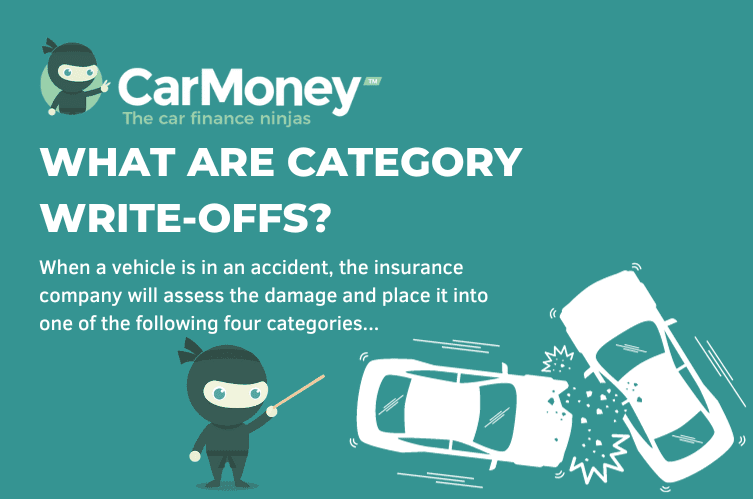What are Category Write-Offs?

When a vehicle is in an accident, the insurance company will assess the damage and place it into one of the following four categories:
Category A:
This is the most severe category your car can fall into. Category A vehicles are described as waste. These are cars that are so badly damaged that they must be scrapped and the entire car – including any salvageable parts – crushed. Category A vehicles must never re-appear on the roads.
Category B:
Vehicles in category B have also suffered extensive damage and are still described as waste, but some parts remain salvageable. In these cases, the body shell of the car should be crushed as the car is not roadworthy. However, reclaimed parts can be salvaged for use in roadworthy cars. Category B vehicles should also never re-appear on roads
Category S (Formerly C):
Category S is a new category and refers to vehicles that have suffered structural damage. Structural damage can include a bent or twisted chassis or a crumple zone that has completely collapsed. In cases of category S vehicles, the damage suffered is more than just cosmetic. As a result, the insurer will most often decide not to perform the repairs themselves. Instead, these must be carried out by a specialist to a standard that is roadworthy.
Category N (Formerly D):
The least severe category for your vehicle to fall into is category N, the second of the new categories. Cars in this category haven’t sustained any structural damage. This means category N write-offs will be for cosmetic or electrical reasons. Until repairs are made these cars are still not safe to drive.
How do I know if it’s written off?
An insurance write-off check will identify if any car has previously been written off. There are multiple websites you can use to check this. It is the insurance company that writes off a vehicle after an accident, often because the repair costs will far exceed what the car itself is worth, or if the damage is too severe.
Why did Category C + D Change?
Formerly known as Category C and Category D, both Category S and N relate to cars that can be returned to the road if properly repaired. According to the Association of British Insurers (ABI), such write-offs are “repairable total-loss vehicles where repair costs including VAT do not exceed the vehicle’s pre-accident value”.
Before these changes were made, categories C and D were governed by the cost of repair that was estimated by your insurer. These changes came into effect because some insurers were quick to condemn a vehicle to be crushed if the car cost more than half of its value to repair. This led to more and more cars that would otherwise be safe and drivable being prematurely scrapped. The introduction of these new categories has aimed to decrease this.
Is it Worth Buying a Category Write-Off?
Cat S and Cat N cars are generally worth far less than equivalent cars that haven’t been involved in a collision, so they can look like good value. Just make sure that any accident damage has been fully repaired to the legal standards. Once a car is written off as a Cat S or Cat N, this marker is permanent, and cannot be changed. It will also reduce the future resale value of a car, meaning you’ll get less when you come to resell it.
A Cat S or Cat N marker can sometimes be given to cars with relatively minor damage. An older, low-value car might be written off after a light scrape in a car park, simply because the cost of processing the insurance claim exceeds the car’s value.
Is a Write-Off more Expensive to Insure?
Don’t expect insuring your Cat N or S car to be straightforward. Some insurers won’t consider covering such a car and those that do may charge a higher premium. An engineer’s inspection report will certainly smooth the way.
Thanks to the Consumer Rights Act 2015, car buyers are better protected since the law states that any goods purchased should be ‘of satisfactory quality’, ‘fit for purpose’ and ‘as described’, so you should be able to get the vehicle insured.
In theory, there’s no reason why you shouldn’t consider a Cat S or Cat N car if it’s been properly repaired, but there are hundreds of thousands of cars on sale that haven’t been written off. Unless you’re really drawn by the lower price, and can put up with potentially higher insurance and lower resale costs, we’d recommend you avoid buying a written-off car if you can.
If you’re looking for more information on which cars you can afford on finance, check out our car finance calculator.














